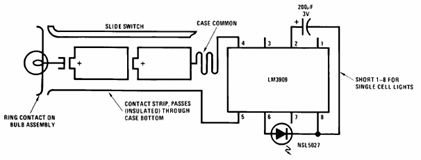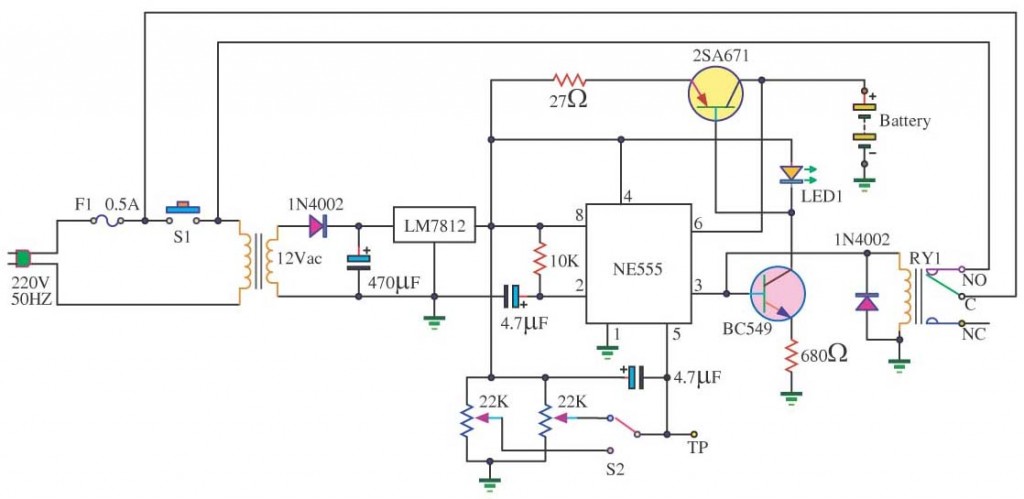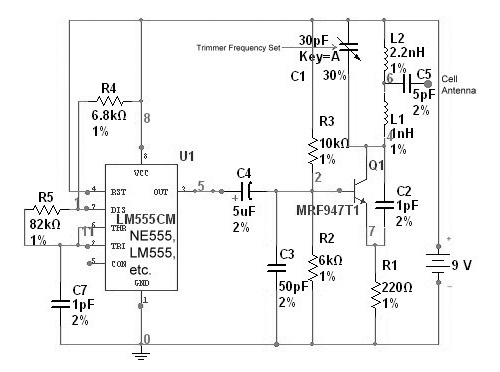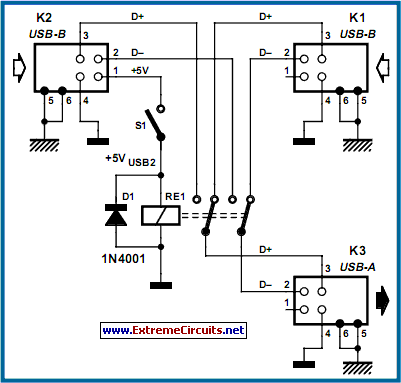
15V TOP224Y 2A DC output switching power supply circuit
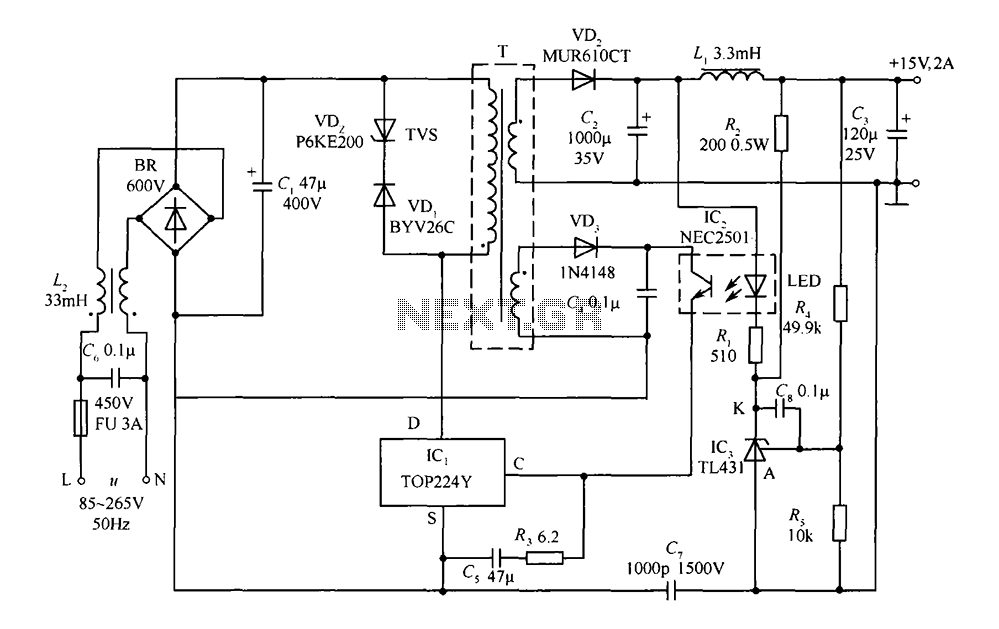
This circuit comprises a 15V TOP224Y, 2A output DC switching power supply. It utilizes three integrated circuits: IC1 is a monolithic regulator (TOP224Y), IC2 is an optocoupler (NEC2501), and IC3 is a precision voltage reference (TL431). The TL431 (IC3) and the NEC2501 optocoupler (IC2) form an electrically isolated external error amplifier. The internal error amplifier of the TOP224Y (IC1) is used alongside a control terminal for fine adjustment of current, significantly enhancing the regulator's performance. The 15V regulated output is achieved through a voltage sampling method using resistors R4 and R5, which derive a voltage based on the TL431's internal 2.5V reference. Adjustments to the K-side potential control the LED current, thus regulating the control terminal current (Ic). Resistor R1 limits the LED current, allowing for control of the loop's DC gain. The frequency characteristics of the external error amplifier are determined by R4 and capacitor C8. The regulation accuracy of the power supply is comparable to that of integrated linear power supplies: when the AC input voltage varies from 85V to 265V, the output voltage stability (Sv) is 0.2%; when the load current changes from 10% (0.2A) to 100% (2A), the load regulation (Sl) can also achieve 0.2%. Additionally, a 5V TOP414G, 2A output isolated switching power supply is also mentioned.
This circuit design features a 15V DC switching power supply utilizing the TOP224Y regulator, which is well-regarded for its efficiency and compact design. The integration of the NEC2501 optocoupler and the TL431 voltage reference enhances the circuit's ability to maintain stable output under varying conditions. The use of the TL431 as an external error amplifier allows for improved performance by providing feedback that isolates the control loop from fluctuations in the power supply input.
The resistors R4 and R5 are critical for voltage feedback, sampling the output voltage to ensure it remains within the desired range. By setting the appropriate values for R4 and R5, the designer can achieve the necessary voltage division to match the TL431's reference voltage, thus maintaining regulation. The inclusion of capacitor C8 alongside R4 serves to filter any noise and stabilize the feedback loop, ensuring a smooth response to load changes.
The LED current is controlled through the adjustment of the K-side potential, which directly influences the current flowing through the LED and, consequently, the feedback to the TOP224Y. This feedback mechanism allows for real-time adjustments to the output voltage, enhancing the overall stability of the power supply.
The performance metrics indicate that the power supply exhibits minimal variation in output voltage despite significant changes in input voltage and load current, making it suitable for applications requiring high reliability. The additional mention of a 5V isolated switching power supply using the TOP414G further illustrates the versatility of this design approach, allowing for multiple output configurations from a single power supply architecture.Constituted by a 15V TOP224Y, 2A output DC switching power supply circuit shown in FIG. Using three integrated circuits: ICl is a monolithic regulator TOP224Y, IC2 is optocoupl ers NEC2501, IC3 is a precision voltage reference TL431. TL431 (IC3) and the optocoupler NEC2501 (IC2) constituting the electrically isolated external error amplifier, and then with TOP224Y internal error amplifier with the use of TOP224Y (IC1) a control terminal of the current fine adjustment, thus greatly improving the performance of the regulator.+ 15V regulated output by R4, R5 partial pressure sampling voltage obtained with the TL431 internal 2.5V reference voltage, by changing the K-side potential to control the LED current, thereby regulating the control terminal current Ic. Rl is LED current limiting resistor, and can set the control loop DC gain. R4 and C8 also determines the frequency characteristics of the external error amplifier. Regulation accuracy of the power supply with integrated linear power supply comparable: u When the AC input voltage from 85V to change when 265V, Sv 0.2%; When the load current from 10% (0.2A) is changed to 100% (2A time), Sl can reach 0.2%.3.1.8 constituted by a 5V TOP414G, 2A output isolated switching power supply
This circuit design features a 15V DC switching power supply utilizing the TOP224Y regulator, which is well-regarded for its efficiency and compact design. The integration of the NEC2501 optocoupler and the TL431 voltage reference enhances the circuit's ability to maintain stable output under varying conditions. The use of the TL431 as an external error amplifier allows for improved performance by providing feedback that isolates the control loop from fluctuations in the power supply input.
The resistors R4 and R5 are critical for voltage feedback, sampling the output voltage to ensure it remains within the desired range. By setting the appropriate values for R4 and R5, the designer can achieve the necessary voltage division to match the TL431's reference voltage, thus maintaining regulation. The inclusion of capacitor C8 alongside R4 serves to filter any noise and stabilize the feedback loop, ensuring a smooth response to load changes.
The LED current is controlled through the adjustment of the K-side potential, which directly influences the current flowing through the LED and, consequently, the feedback to the TOP224Y. This feedback mechanism allows for real-time adjustments to the output voltage, enhancing the overall stability of the power supply.
The performance metrics indicate that the power supply exhibits minimal variation in output voltage despite significant changes in input voltage and load current, making it suitable for applications requiring high reliability. The additional mention of a 5V isolated switching power supply using the TOP414G further illustrates the versatility of this design approach, allowing for multiple output configurations from a single power supply architecture.Constituted by a 15V TOP224Y, 2A output DC switching power supply circuit shown in FIG. Using three integrated circuits: ICl is a monolithic regulator TOP224Y, IC2 is optocoupl ers NEC2501, IC3 is a precision voltage reference TL431. TL431 (IC3) and the optocoupler NEC2501 (IC2) constituting the electrically isolated external error amplifier, and then with TOP224Y internal error amplifier with the use of TOP224Y (IC1) a control terminal of the current fine adjustment, thus greatly improving the performance of the regulator.+ 15V regulated output by R4, R5 partial pressure sampling voltage obtained with the TL431 internal 2.5V reference voltage, by changing the K-side potential to control the LED current, thereby regulating the control terminal current Ic. Rl is LED current limiting resistor, and can set the control loop DC gain. R4 and C8 also determines the frequency characteristics of the external error amplifier. Regulation accuracy of the power supply with integrated linear power supply comparable: u When the AC input voltage from 85V to change when 265V, Sv 0.2%; When the load current from 10% (0.2A) is changed to 100% (2A time), Sl can reach 0.2%.3.1.8 constituted by a 5V TOP414G, 2A output isolated switching power supply
